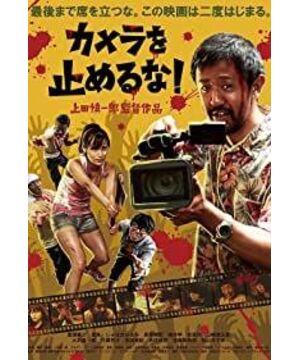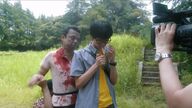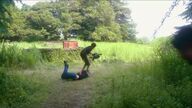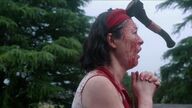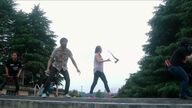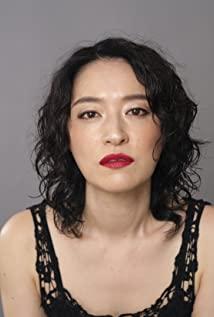An uncomplicated story structure, the first part is a very rough 40-minute long shot, this 40-minute long shot is this "one shot to the end" zombie movie. The second part goes back a month and tells us how these actors came together to make this film in the process of stumbling. If this film were carried out in normal chronological order, it would be a simple or even a whole film with a large texture.
Really no-frills lighting, purely random hand-held camera shake, lots of redundant camera movement, and noticeable pauses: the heroine screams and pushes a big close-up to her flamboyant performance that lasts for a long time, the shot The small amount of information and the long duration give the audience a psychological sense of the duration of this scene compared to the whole body shot of the huge amount of movement and information brought by some of the female protagonists killing everyone at the end of this section. The rhythm this section brings to people It's pretty bizarre, and so is the moment when the zombies appear and the glasses guy loses his hand, and of course we can learn what the crew is doing behind these obviously flawed rhythm scenes in the second half of the film.
Therefore, the structure of the film is worth pondering. According to the narrative sequence and completion quality of this film, when we watch the "feature film", we feel that we are fully aware of the existence of the camera. The tolerance for the extremely low quality and high degree of completion of the film in the first 40 minutes is very good in the latter part. freed.
The slot points in the "positive film" of "Camera" are roughly summarized as follows: 1. The extremely unreasonable lens rhythm, including but not limited to this, as mentioned above With the existence of a character, we will wonder whether the "photographer" is a real recorder character in the feature film (so why was the photographer not bitten by a zombie) or a gang who accidentally appeared for a shot? In fact, in any case, the explanation is that the quality of the main film is not high. 3. All kinds of rough and unthought-out shots are connected. In order to elicit the next scene, the reaction of the characters who follow the previous scene is deliberately ignored, such as meeting for the first time. Zombies, the camera first followed the bald uncle out and then the glasses brother appeared, and then the eyes completely focused on the glasses brother fighting the zombies. Of course, after a long period of low-quality close-up shots, the camera returned to the indoor part of the broken hand, while the bald uncle Already trembling and hiding in the back, the incoherence of perspective and the style of one-shot to the end cause us to break the connection between time and emotions during this time, and it brings us a rough look and feel.
The impression that this series of slots gives us is: we realize that this is a movie about zombies, we will put ourselves into the context of the feature film at the beginning and think that these zombies really exist and break into the crew, and at the same time we I will question how such a dazzling one shot is so rough and so poor as a positive film. However, the anger over the film came to an abrupt end at the end of the 36-minute feature film. The camera suddenly fell unsteadily, and we realized that "The Camera Don't Stop" was shooting a "positive film", and the back was a flashback to explain why such a "positive film" appeared.
The requirements of one shot to the end, the poor crew, and the helplessness of the new director, but the director still decided to make a zombie film of his own. The second half of the film is to introduce how the director gathered a film crew to complete the film. The story, "one shot to the end", "zombies" and other elements have become a hard setting. Various problems in the feature film are completed at the end, especially the same rising shot at the end, and the same pattern as the end of the "feature film" is completed. Nesting: The "feature film" is what the director in "Camera" wants to work hard to complete, and "Camera" is also the film that Ueda Shinichiro strives to complete.
However, I personally think that such films with meta-movie properties such as "feature films", "posts" and nesting are speculative in the presentation of "Camera", and the film has a very low degree of completion of the difficult scheduling of long shots. Blame it on a hard setting and low cost, which is also a supplement for the film "Camera", but if the quality of this film is divided into two parts, we can see that the completion of the two parts is not high, The combination of the two paragraphs is only a low-quality paragraph explaining each other, and the quality of the whole film is not very high, just an inspirational story. I don't think this is an excellent way of storytelling, and the meta-movie element is just a simple way to cater to the audience, because the whole film's idea simply stays on the inspirational director to complete his own one-shot zombie movie story. Regarding the insinuation of the viewing mechanism of movie audiences, we have less desire for the satisfaction of the expected value after we have already understood the completion of this "feature film". The only thing we may expect is to understand how to complete this one shot to the end instead of having Unfinished, such expectations are not the core of the dramatic conflict, and at the same time are diluted by various additional comedy elements, so the elements of the meta movie have actually been eliminated as much as possible, so I personally think this is just Ueda Shinichiro's own obsession to complete it. .
View more about One Cut of the Dead reviews


